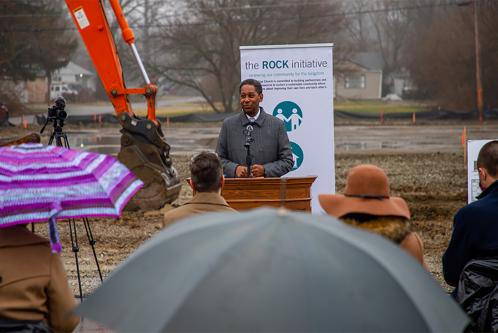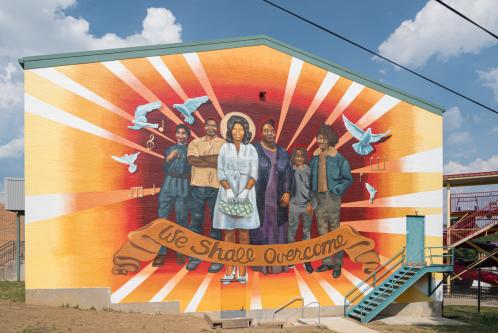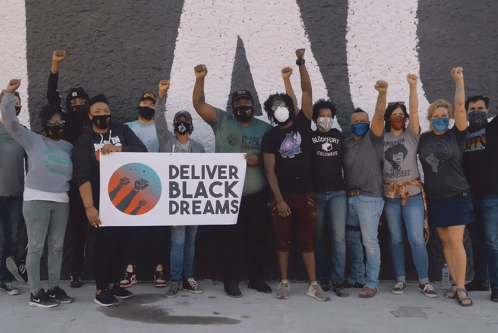
About the Program
Delivering capital, expertise and collaboration to nine neighborhoods creating economic mobility.

The Commitment
Fifth Third's $2.8 billion Accelerating Racial Equity, Equality and Inclusion initiative will provide $2.2 billion in lending, $500 million in investments, $60 million in financial accessibility and $40 million in philanthropy.
The commitment focuses on four strategic pillars that directly impact Fifth Third’s customers and communities:
- Strategic investments
- Access to capital
- Financial inclusion and education
- Social justice and advocacy
The Fifth Third Empowering Black Futures Neighborhood Program is a cornerstone of Fifth Third’s Accelerating Racial Equity, Equality and Inclusion initiative.
Fifth Third selected Enterprise Community Partners to lead the Fifth Third Empowering Black Futures Neighborhood Program, created to promote economic mobility in nine neighborhoods that have historically experienced disinvestment and whose residents are predominantly Black. In working with the neighborhoods, Enterprise will leverage its national program and technical assistance platform, along with 40 years of experience partnering with communities across the United States.
Enterprise’s mission is to make home and community places of pride, power and belonging, and platforms for resilience and upward mobility for all. The Fifth Third Empowering Black Futures Neighborhood Program embodies Enterprise’s strategic plan to increase housing supply, advance racial equity, and build resilience and upward mobility.
The Approach
The Fifth Third Empowering Black Futures Neighborhood Program will span three years and deliver comprehensive support – including capital, collaboration and expertise – to nine neighborhoods across Fifth Third’s retail banking footprint.
Fifth Third is committing up to $20 million in lending, investments and philanthropy to each of the nine neighborhoods, depending on its opportunities, needs and economic mobility plan.
Ninety percent of the funds represent a combination of capital, products and services for small business, mortgage and neighborhood revitalization loans and investments. Ten percent of the dollars will be invested in philanthropic efforts.
In March 2021, Fifth Third and Enterprise invited a group of organizations to apply to be one of the nine neighborhoods selected for the program, based on specific criteria. The criteria included partnering with the neighborhood’s Black residents, existing neighborhood infrastructure and the organization’s ability to manage equitable investment and wealth-building opportunities.
As part of the invitation-only application process, the organizations were asked to show how participation in the Fifth Third Empowering Black Futures Neighborhood Program would help achieve cross-sector neighborhood goals, build on existing community assets and address barriers to economic mobility.
Enterprise will provide technical assistance and support to help the nine neighborhoods develop and implement an economic mobility plan. Plans will be tailored to each community’s unique challenges as well as people- and placed-based opportunities. Enterprise will also partner with the neighborhoods to assess how their plan is improving the economic mobility of residents and small businesses.
To promote shared learning and build on promising strategies, Enterprise will create a peer learning platform. Stakeholders from each of the nine neighborhoods will have the opportunity to exchange ideas, learn from their peers’ challenges and successes, and explore ways to scale innovative approaches.
Learnings from the program will also be shared with the larger national affordable housing and community development network.
The Goals
The Fifth Third Empowering Black Futures Neighborhood Program is designed to help revitalize and support the economic mobility of Black residents in nine neighborhoods that have experienced disinvestment, wealth extraction and income disparities due to racial inequities.
Across each of the nine neighborhoods, the program seeks to:
- Create more equitable, connected systems:
Strengthen links across stakeholder groups, including small Black-owned businesses, the community and other institutions and organizations. Improve deployment of Fifth Third lending products in previously underserved areas. - Improve upward mobility among Black residents:
Increase Black homeownership rates and reduce displacement of Back residents. Generate wealth and a higher sense of value, agency and belonging. - Build an inclusive civic infrastructure:
Strengthen the capacity of local stakeholders to sustain efforts and expand services and programs that support residents’ economic mobility. - Promote prosperous small Black-owned businesses:
Increase entrepreneurship and achieve greater growth and retention of small Black-owned businesses. - Develop healthy, built environments:
Reduce vacancies and abandoned buildings and develop plans for improved walkability and availability of open spaces.
The program also aims to cultivate investments and resources from additional stakeholders seeking to support the economic mobility of Black residents in the nine selected neighborhoods.








